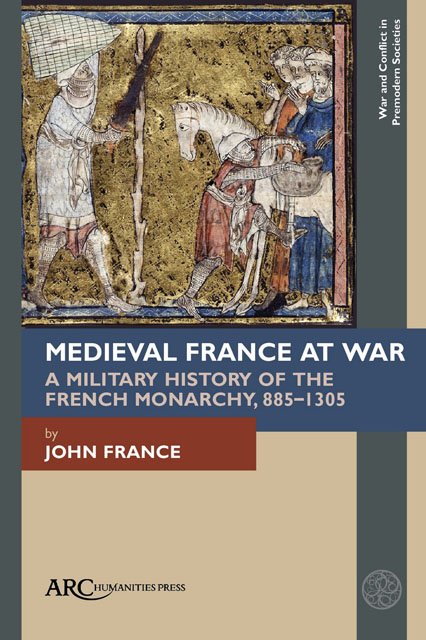307 results
Chivalry and Violence in Late Medieval Castile. Samuel A. Claussen. Woodbridge: Boydell & Brewer, 2020. 244 pp. $95.
-
- Journal:
- Renaissance Quarterly / Volume 76 / Issue 4 / Winter 2023
- Published online by Cambridge University Press:
- 24 January 2024, pp. 1526-1527
- Print publication:
- Winter 2023
-
- Article
- Export citation
Pilot study of a ketogenic diet in bipolar disorder
-
- Journal:
- BJPsych Open / Volume 9 / Issue 6 / November 2023
- Published online by Cambridge University Press:
- 10 October 2023, e176
-
- Article
-
- You have access
- Open access
- HTML
- Export citation
Journal of Medieval Military History 1477-545X
-
- Book:
- Journal of Medieval Military History XXI
- Published by:
- Boydell & Brewer
- Published online:
- 10 January 2024
- Print publication:
- 06 June 2023, pp 261-265
-
- Chapter
- Export citation
List of Illustrations
-
- Book:
- Journal of Medieval Military History XXI
- Published by:
- Boydell & Brewer
- Published online:
- 10 January 2024
- Print publication:
- 06 June 2023, pp vii-x
-
- Chapter
- Export citation
List of Contributors
-
- Book:
- Journal of Medieval Military History XXI
- Published by:
- Boydell & Brewer
- Published online:
- 10 January 2024
- Print publication:
- 06 June 2023, pp 259-260
-
- Chapter
- Export citation

Journal of Medieval Military History XXI
-
- Published by:
- Boydell & Brewer
- Published online:
- 10 January 2024
- Print publication:
- 06 June 2023
Frontmatter
-
- Book:
- Journal of Medieval Military History XXI
- Published by:
- Boydell & Brewer
- Published online:
- 10 January 2024
- Print publication:
- 06 June 2023, pp i-iv
-
- Chapter
- Export citation
Contents
-
- Book:
- Journal of Medieval Military History XXI
- Published by:
- Boydell & Brewer
- Published online:
- 10 January 2024
- Print publication:
- 06 June 2023, pp v-vi
-
- Chapter
- Export citation

Medieval France at War
- A Military History of the French Monarchy, 885-1305
-
- Published by:
- Amsterdam University Press
- Published online:
- 06 April 2023
- Print publication:
- 30 November 2022
Frontmatter
-
- Book:
- Medieval France at War
- Published by:
- Amsterdam University Press
- Published online:
- 06 April 2023
- Print publication:
- 30 November 2022, pp i-iv
-
- Chapter
- Export citation
Chapter 3 - French Monarchical Power in Context
-
- Book:
- Medieval France at War
- Published by:
- Amsterdam University Press
- Published online:
- 06 April 2023
- Print publication:
- 30 November 2022, pp 35-48
-
- Chapter
- Export citation
Preface
-
-
- Book:
- Medieval France at War
- Published by:
- Amsterdam University Press
- Published online:
- 06 April 2023
- Print publication:
- 30 November 2022, pp viii-viii
-
- Chapter
- Export citation
Bibliography
-
- Book:
- Medieval France at War
- Published by:
- Amsterdam University Press
- Published online:
- 06 April 2023
- Print publication:
- 30 November 2022, pp 215-236
-
- Chapter
- Export citation
Chapter 10 - Perspectives on The Army of The Kings of France
-
- Book:
- Medieval France at War
- Published by:
- Amsterdam University Press
- Published online:
- 06 April 2023
- Print publication:
- 30 November 2022, pp 209-214
-
- Chapter
- Export citation
Chapter 6 - Philip Ii and The Rise of France
-
- Book:
- Medieval France at War
- Published by:
- Amsterdam University Press
- Published online:
- 06 April 2023
- Print publication:
- 30 November 2022, pp 113-146
-
- Chapter
- Export citation
Chapter 7 - The Expansion of France
-
- Book:
- Medieval France at War
- Published by:
- Amsterdam University Press
- Published online:
- 06 April 2023
- Print publication:
- 30 November 2022, pp 147-164
-
- Chapter
- Export citation
Introduction
-
- Book:
- Medieval France at War
- Published by:
- Amsterdam University Press
- Published online:
- 06 April 2023
- Print publication:
- 30 November 2022, pp 1-6
-
- Chapter
- Export citation
Chapter 2 - The Emergence Of France
-
- Book:
- Medieval France at War
- Published by:
- Amsterdam University Press
- Published online:
- 06 April 2023
- Print publication:
- 30 November 2022, pp 25-34
-
- Chapter
- Export citation
Chapter 8 - Louis Ix and The Apogee Of French Power
-
- Book:
- Medieval France at War
- Published by:
- Amsterdam University Press
- Published online:
- 06 April 2023
- Print publication:
- 30 November 2022, pp 165-188
-
- Chapter
- Export citation
Contents
-
- Book:
- Medieval France at War
- Published by:
- Amsterdam University Press
- Published online:
- 06 April 2023
- Print publication:
- 30 November 2022, pp v-v
-
- Chapter
- Export citation



